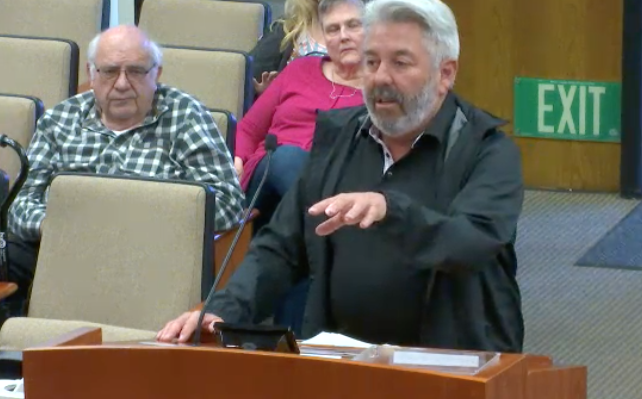
The Cypress City Council’s ruling majority on Monday ratified the map it created at the last minute after a more than two-year process and by the same 3-2 vote.
The Council voted 3-2 to finally adopt Map 146, a map that was created at the last meeting at the 11th hour by Mayor Scott Minikus and then supported by Mayor Pro-tem Bonnie Peat and Council member Anne Hertz Mallari.
The same three members voted to approve the new map on Monday upon the “second reading” of the resolution, making it the official blueprint for the City of Cypress from which all future Councils will be elected (until the census of 2030).
The ruling majority vigorously defended the vote as members of the public and the two opposing Council members hurled incredulous claims of unfairness and even gerrymandering at the Council’s ruling majority.
(The term “gerrymandering” has been used to suggest favorable voting map making since Massachusetts Governor Eldrige Gerry in 1812 signed a bill that created an electoral district so unartfully created that it resembled a salamander).
At its March 11 meeting, after a process that forced residents to submit maps for approval in early February, and after a gaggle of residents had expressed approval of two maps submitted, Minikus without warning proposed taking the top of a map that “nobody wanted” and merging with another map to create the final district.
Council member Frances Marquez told Minikus that if he wanted this configuration, he should have submitted a map by the deadline like everyone else.
“The other comment that was made about me was that I didn’t submit a map,” he said.
“And I’ll tell you, I intentionally didn’t submit a map, because I didn’t want to give the appearance of any favoritism one way or the other. So that was my logic with that,” the mayor said.
Even though the new configuration ironically removed Hertz-Mallari from the same district as Peat and placed her in a district with Council member David Burke, the three Council members defended the new district as best for the city.
First, however, came the debate over the 11th-hour map’s legality.
Even though the new map created on the fly was not posted before the vote, it had been created from pieces of maps that had been posted and since it was approved on Feb. 26, it was posted on the city’s website since 10 p.m. that night and thus, it was legally created said Fred Galante, the city’s legal advisor.
In addition, he said “the map has been reviewed by the consultants you’ve retained and found to be in the appropriate form. It meets the criteria of the elections code and Fair Maps Act,” he added.
“Just to kind of check in on this,” said Hertz Mallari, “the map that Council adopted has been approved by the plaintiffs.”
“That’s a critical point I forgot to highlight, so thank you,” said Galante.
Kevin Shenkman, attorney for the plaintiffs (Dr. Malini Nagpal, Katie Shapiro, and the Southwest Voter Registration project), called in to say while they did approve the map, they did not endorse the way it was adopted.
“The point is. we did in fact, accept the math and sequencing of Map 146 and districts three and four being up (for election) in this November,” said Shenkman, “but that should not be misconstrued as a belief by plaintiffs that 146 is necessarily the best, regardless of being acceptable, nor should that be construed as an indication that plaintiffs believe that the process, particularly at the last Council meeting, was necessarily ideal.”
This was followed by what turned out to be several skirmishes, albeit subtle, being Burke and Galante over the legality of the majority’s last-minute move at the previous meeting.
“I disagree that the process that was followed to select this map complies with all the applicable laws,” said Burke.
“I know the city attorney said it’s not technically finally adopted until this ordinance tonight,” said Burke, “but we said it was adopted on the city’s website. So to me, that doesn’t sound like we comply with the requirements of the elections.’
He said the elections code cites the map has to be published at least seven days before consideration of a hearing.
“And then, any revised maps must be available seven days before being adopted. In this case, map 146 was considered and voted on Feb. 26. But it was not published seven days before that hearing and that’s why I have doubts about the legality of it,” said Burke.
Peat retorted, asking Galante, “This is a tricky question, so I apologize for asking, but … are we going to get sued?”
“I have not heard or seen any reason why the council’s action violated the law as I mentioned. And I think it’s just worth reading … and this is straight out of election code section 107,” Galante repeated.
Nevertheless, Burke proposed in a point-by-point presentation to the Council to at least take a breath, schedule a public hearing, allow citizens to have input on the map and then adopt the new ordinance.
“My main concern is that [if] we approve this map, we are running the risk of being sued again. Many residents have reached out to me to tell me they thought the map decision was political,” he said.
Burke suggested map 146 splits three communities of interest by using residential streets, not major highways and landmarks, to separate the district.
“In light of that, I think we fell short of our duty to residents to give them the information they needed to participate in the process and weigh in on whether they thought it was a good map,” he said.
Peat took offense at the suggestion of political tinkering and gerrymandering.
“Council member Burke mentioned that he had several residents that had talked to him about ‘accusing us gerrymandering,’ and therefore he is accusing us of gerrymandering,” she said.
“Because he’s making the comment, I’m offended, I’ll be honest with you, I am completely authentic,” she said.
“If you look at the demographics, the new map adds more Latinos to her district and makes it a minority district, including more ‘like’ communities,” Peat continued.
“If you look at that, and you say I have a 59% minority district if you add up Asians and you add up Hispanics. I don’t like talking in these terms. I apologize, but I’m saying it for a point,” the Mayor Pro-tem said.
“We achieved an objective that we weren’t even asked to achieve,” in creating two, not one, minority-majority districts, she suggested.
Wait a minute, Burke inferred, the district in which Peat resides was already a minority district, even before the Minikus realignment.
“I want to address the difference between the two maps that are being talked about in terms of the Latino vote being added,” said Burke.
“I feel like it’s sort of being oversold,” said Burke, “the extent to which Map 146 is so much better than Map 133 in that regard. He said District Two on that map already contained a 59 percent Asian/Hispanic majority before the last-minute switch.
“It was already a majority-minority district,” argued Burke. He acknowledged that the new configuration in Map 146 increased those communities by five points, but that’s it.
“If you combine the Asian/Hispanic vote in District Two (Map 133), it was already a majority-minority district,” he added. Although the new map does increase the minority vote by five percentage points, from 59 to 64 percent.
Hertz Mallari said the new map is best for the city.
“We should not be forced to do maps, but the law is the law. And that is what we’re doing,” she said. “We decided to make that decision (to settle) after almost two years of fighting.,” said Hertz-Mallari.
“But at no point do I actually think district elections are good,” she added.
“If you look at the maps,” Hertz Mallari said, “not only Council Member (Frances) Marquez is unable to run until 2026, but so am I, and the discussion over the top half of the map, regardless of which map you choose, I am either in a district with Council member Burke or I’m in a district with Mayor Pro Tem Peat.”
“My job is not to protect my seat,” she argued.
Marquez keeps reminding the Council, and the public, that she urged the previous Council and this one to settle in 2021 for $35,000.
Although Hertz Mallari questioned Marquez’ estimate of up to a million dollars wasted, the settlement agreement requires the city to pay legal bills yet to be submitted that could in themselves be seven figures.
Marquez also said a process that started crossways has remained that way throughout. “How could any council member ethically vote on a measure so consequential for which they had no underlying data?”
“That was unethical that we voted on something that was not in front of us. I couldn’t see any data. How can I make an ethical vote, if there’s no map in front of us, there’s no data, and then the residents weren’t able to respond,” she said of the Feb. 26 vote.
“Everything was shut down. That’s wrong. That’s not how the government works. You know, we’re supposed to listen to the residents. They voted for us,” she said.
Residents, indeed, let the council know how they felt.
“You guys changed that map,” said Cypress businessman Bob Youngsma. “And yes, you had 10 days before this one, but you didn’t have 10 days before that one. You changed that map. Not one resident saw it. No one said they agreed with that map change at that time because nobody knew it existed,” he said.
“They didn’t even hear a council member agree upon it until the change happened. You had this already planned up front because that’s what it looks like, and the people I’m talking to are saying it appears that way to them. It was planned up front,” he said.
Resident Paul Kokkinos, who has compared the city’s ruling majority to a “cabal,” said,
“This has to do with this historic voting bloc, the ones that approved the combination of the two maps.”
“And it seems to me that this ordinance,” he said, holding up the document in his left hand, before continuing. “I printed it off. It’s already been preordained as if we know that the historic voting bloc is going to vote for it,” Kokkinos said.
(Peat said later this was the standard operating procedure for resolutions being voted on).
“The historic voting bloc that I’ve referred to as a cabal in the past will be broken up. And I think that is what we need to do as a city,” said Kokkinos.
“And what you council members need to do as a council is we need to make these next elections for districts three and four more transparent than they’ve ever been before,” said Kokkinos.
Cheryl Benson, who said she was a 50-year resident of Cypress, also suggested what the three-vote majority did was disappointing.
“I’ve been a resident of Cypress for about 50 years. I concur with the other two comments. I don’t think Map 146 is a good distribution of the of Cypress districts,” she said.
Timothy Vink, another resident, asked the Council to reconsider.
“I’m hopeful that you would reconsider the decision to adopt the Maps that hadn’t been considered or I guess, commented on by the public,” said Vink.
“The whole process seems a little out of whack to me, or to have been proposed and then adopted quickly. I’m afraid that the process…is going to cause more problems down the line and lead to more legal challenges,” Vink said.
Both Minikus and Hertz-Mallari couldn’t resist giving Marquez her proverbial slap on the wrist, pointing fingers with no specific evidence after a resident reported seeing her speaking to Shenkman after the meeting.
“Several people in this gallery, including Fred Galante (city attorney) witnessed Ms. Marquez, who is essentially aed defendant in the case, speaking with the plaintiff’s attorney in the parking lot in a dark spot in the parking lot,” said Minikus.
“Did you forget about that meeting, or did you just feel like you didn’t need to disclose or were you hiding it from us,” the Mayor asked. Earlier in the meeting, she had failed to disclose it.
Hertz-Mallari also questioned Marquez when “she (Marquez) left here and then had a very lengthy conversation with opposing counsel. I don’t know why any of us would have that kind of conversation with Mr. Shenkman.”
“If I may, Mr. Mayor,” interjected Galante, “Council member Mallari’s absolutely correct,” the city’s legal advisor said.
“I have nothing to hide,” said Marquez, in essence, reminding the Council that they were discussing the ruling majority’s surprise move, not her brief discussion with Shenkman walking to her car.
Shenkman, following the meeting, said, “If I wanted to meet surreptitiously, of all the places in the world I would not do it is outside Cypress City Hall.”
“Under the rules of professional conduct, Rule 4.2, it generally prohibits a lawyer from communicating, directly or indirectly, about the subject of the representation with a person who is the lawyer knows to be represented by another lawyer in the matter,” said Shenkman.
He continued. “The rule shall not prohibit communications with a public official, board committee or body.”
“She (Marquez) is a public official,” he said, citing the entire rule.
In essence, said Shenkman, “I am allowed to communicate directly without the permission of Fred Galante or anyone else,” said Shenkman.
“Fred knows that,” he added.
And to Minikus’ assertion that workshops were not scheduled for residents because the city manager said timing did not allow, Shenkmam said had the city asked for a one month extension, “the answer would have probably been yes.”











